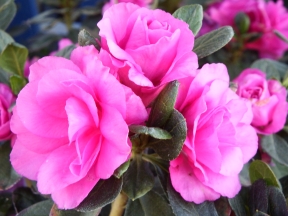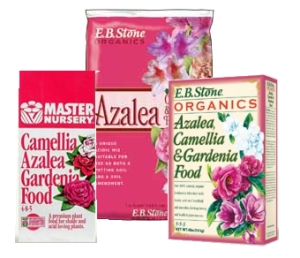Azaleas, Camellias, Rhododendrons, Gardenias, & Hydrangeas Care Guide
Light & Watering Requirements

It is best to plant Azaleas, Camellias, Rhododendrons, and Hydrangeas in a shady location. A north or east side of a house, and/or under a tree with filtered shade is good. Only morning sun is recommended because afternoon sun causes burning on the leaves. Gardenias and deciduous azaleas tolerate more sun and can be planted in areas that get more sun.
Good drainage is important, with consistent regular watering. Amend your soil when planting with EB Stone Azalea, Camellia, and Gardenia Planting Mix. You can also plant directly into the EB STone Azalea, Camellia, and Gardening Planting Mix if you are planting in containers. For optimal health, it is ideal to mulch lightly around your shade loving plants each Fall with the same planting mix. This helps protect roots from cool winter nights & the high summer temperatures.
Fertilizing Recommendations

For Azaleas, Camellias and Rhododendrons use an acidic fertilizer such as EB Stone Organics Azalea, Camelia & Gardenia Food or Master Nursery Azalea, Camellia, Gardenia Food once after bloom(early Spring), once early Summer (June), and once in early Fall (September). If you prefer to use a liquid or water soluble fertilizer you will need to fertilize more often, almost monthly from March - September. To increase and improve flower production, we recommend fertilizing during the Winter months with EB Stone Ultra Bloom or Master Bloom 0-10-10 & GreenAll F.S.T. (iron, sulfur, manganese, and zinc supplement) monthly October through December.
Gardenias & Hydrangeas may want more frequent fertilizing than other shade loving plants. For optimimum performance, we recommend fertilizing with the EB Stone or Master Nursery acidic fertilizer from March thru September. During the Winter months use EB Stone Ultra Bloom or Master Bloom 0-10-10 & F.S.T. once a month from November through January for improved flowering in the Spring and Summer.
If you would like improve the blue color of your hydrangeas or change them to blue, then we recommend you apply the Master Nursery Hydra Blue three times between November & May.
Pruning Guidelines
The optimal time to prune azaleas, camellias, gardenias and rhododendrons is after your plants have bloomed. However, you can prune during other times of the year for shaping purposes. Just remember that if you prune heavily at the wrong time, your plant may not flower as much the following season. It's a good idea to remove spent flowers to keep plants and surrounding area clean and free from disease.
There are now several varieties of hydrangeas available and the timing of when to prune will vary slightly depending on the type of hydrangea. Hydrangeas can be pruned lightly at any time to control form. The older varieties that typically bloom just once in the summer should receive a heavy pruning after they have finished blooming in the late summer. This will give them time to develop enough new growth before the Winter for next year's flowers. The newer hybrids that are repeat bloomers can be cut back severely in the Fall if needed and will still bloom in the spring because they bloom on old and new wood.
Common Problems
Insect Problems
Some of the more common insects found on azaleas, gardenias, rhododendrons, and other shade loving plants are aphids, scale, thrip, and lace bugs. If you happen to see a trail of ants going up your plant, you probably have aphids or scale. Another indication of these insects is a sticky residue on the leaves. Most of the insects will be found on the backside of the leaves. Scales may be found along the branches as well and will look like bumps along the limbs. Scales can be white, black, or brown. These insects are seen most often in the Spring and Fall, but can be a problem at any time of the year. For control of these insects, you may consider using one of these products: Master Nursery Pestfighter Oil, Bonide Eight, Take Down Garden Spray, or Malathion.
Yellowing Leaves
Yellow leaves can be a result of several things. It could be a lack of fertilizer and minerals, a watering problem, or insect damage. When diagnosing a problem, take into account how often you water, when and how often you fertilize, and when the last time you inspected your plant for insects. If the older leaves are turning yellow and the other leaves are a pale green, then you may need to fertilize. If the leaves are yellowing, but the veins on the leaves are green, then your shrub most likely needs iron. If the outer leaves are yellowing and some of the branches are dying back, you may have a watering issue. Inspect the soil to see how moist the soil is and adjust your watering accordingly. Leaves that are being damaged by insects will also turn yellow. Inspect the leaves, especially the backside, to look for insects and then use the appropriate insect control to eliminate the insects.